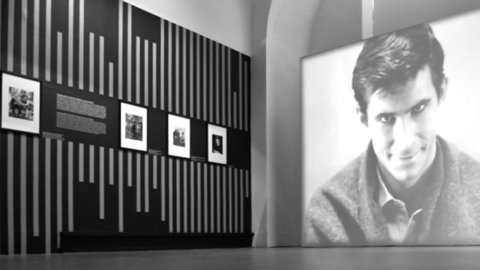More than thirty years have passed since the death of the wizard of suspense who terrified – and perhaps continues to terrify – millions of spectators with his masterpieces. During his career, Alfred Hitchcock made over fifty films - from the silent film era to the XNUMXs - which, over time, have made him one of the most influential and revered cinematic innovators of all time.
The aim of the exhibition is to try to investigate and recreate that Hitchcockian suspense effect, that perfect combination of elements which, over the years, has kept many spectators in suspense in a motel shower, looking out over a courtyard to spy on the neighbors or dealing with furious birds. Hitchcock worked on the scenes of his films with the aim of keeping viewers in suspense as long as possible, as he himself stated:
“If you detonate a bomb the audience has ten seconds of shock, whereas if you simply make them aware of the presence of a bomb, the suspense can be dilated and the audience kept in suspense for five minutes.”
The exhibition itinerary tells the figure of Alfred Hitchcock through the main signed masterpieces Universal Pictures, the famous production house which, acquiring Paramount Pictures, produced his films from 1940 to 1976. A decidedly profitable collaboration which brought unforgettable and inimitable masterpieces to the big screen such as "Psyco", "Rear Window", " The Birds”, “The Woman Who Lived Twice” and many others.
The exhibition presents seventy photographs and special contents from the archives of the American major which, to preserve the quality of these works, has restored the fourteen original films in audio and video bringing them in high definition on Blu-ray™ disc for home video viewing. The work done for the re-edition of these films and the material collected is the basis on which the exhibition has been structured. The public will be able to immerse themselves in the backstage of Hitchcock's main films, discovering curious details on the making of the most famous scenes, on the use of the first special effects, on the actors and on the private life of the great master.
The film critic Gianni Canova will accompany the visitor, with a series of video insights, along the exhibition analyzing the main masterpieces of the British director signed by Universal Pictures.
First among all “Psycho” (1960), one of his most controversial and innovative works. A milestone of thrill cinema that, in 1960, managed to break all box office records and made the audience flee from theaters in a panic.
An opportunity to see the metaphysical Bates motel from behind the scenes, the disturbing character of Norman, the double personality of Marion, the famous shower scene and the fundamental role of Alma Reville, the wife-adviser of the master of thrill.
A room of the itinerary will be dedicated to "Birds" (1963) whose 50th anniversary is being celebrated this year. A shocking masterpiece in which the director introduced numerous innovations in the field of sound and special effects: with 370 shooting tricks, the film required almost three years of preparation due to its technical complexity.
The public will be able to discover curious details on the ingenious devices used to create the most memorable scenes.
The visitor will also have the opportunity to relive the voyeuristic experience of "Jeff" - played by James Stewart - the protagonist of "Court Window" (1954). To the criticism of the London Observer newspaper who called it a "horrible" film because "there was a guy who constantly looked out the window", Hitchcock - in the famous interview given to François Truffaut - replied:
“…yes, the man was a voyeur, but aren't we all voyeurs? Shall we bet that nine out of ten people, if they see across the courtyard a woman undressing before going to bed or simply a man tidying up her room, can't help but look? They could avert their eyes saying: «it doesn't concern me», they could close their shutters, but instead they don't, they will just stand there and watch.
The film was a great success, it was released in August 1954, and by May 1956 it had already grossed $10 million. Dissatisfied with the first location shots, Hitchcock decided to shoot the film on a single set, resulting in the largest film set ever built at the time.
The public will also be able to relive the ambiguous identity of "The Woman Who Lived Twice" (1958), a masterpiece that has become an object of veneration. One of cinema's most harrowing love stories, told through an infinite number of extraordinary angles and shots in the most famous places in San Francisco.
A story through the fears, obsession and psychology of the characters enriched by the statements of actress Kim Novak, the icy blonde female protagonist of the film.
The visitor will also have the opportunity to admire photographic material of the other famous Hitchcockian films: "Saboteurs" (1942) “Shadow of a Doubt” (1943) "Lump in the Throat" (1948) "The Conspiracy of the Innocents" (1955) "The Man Who Knew Too Much" (1956) “Marnie” (1964) "The Torn Curtain" (1966), “Topaz” (1969) “Frenzy” (1972) and "Family Plot" (1976), his last film.
Although Hitchcock attaches great importance to silence in suspense scenes, some of his best known sequences would not have obtained the same dramatic power that everyone recognizes, were it not for the contribution of music.
The soundtrack therefore becomes an integral and fundamental part for the construction of the Hitchcockian sense of expectation. In one room along the itinerary, it will be possible to listen to the music that has strongly characterized some of his films, including that of Bernard Herrmann, an American composer who wrote, among others, the famous soundtracks for "The Woman Who Lived Twice" and the cult “Psycho”.
You will be able to immerse yourself in the electronic sounds of the seagulls that Hitchcock decided to use in the film "The Birds" instead of music: a highly experimental technique for those times which turned out to be very effective.
Along the way an amusing montage of the cameos will showcase Hitchcock's famous appearances in his films. Born as funny gags, cameos became a real superstition over time. The public began to wait for them impatiently and to prevent the viewer from getting too distracted during the film, the director decided to anticipate them to the very first minutes of the beginning.
Thrill, terror but also irony. Another characteristic that distinguishes his works is in fact that successful mix between comedy and suspense: brilliant jokes and funny characters coexist harmoniously together with tense scenes. A synthetic and pungent sense of humor that we find not only in his films but also in his private life.
"Alfred Hitchcock in the films of Universal Pictures" is an exhibition promoted and produced by the Municipality of Milan - Culture, Palazzo Reale, Alef-cultural project management with the special collaboration of Universal Pictures Italia Home Entertainment division.
Until 22 September 2013
Royal Palace,
Piazza Duomo 12, Milan
Opening hours
Monday 14.30pm - 19.30pm
Tuesday, Wednesday, Friday and Sunday 9.30 – 19.30
Thursday and Saturday 9.30 – 22.30





